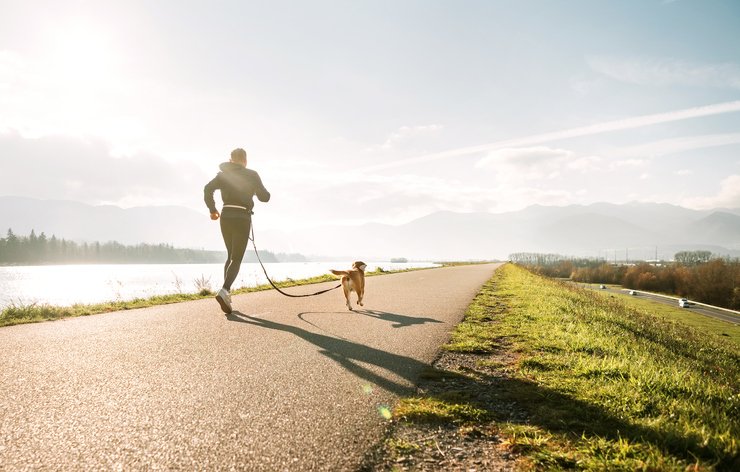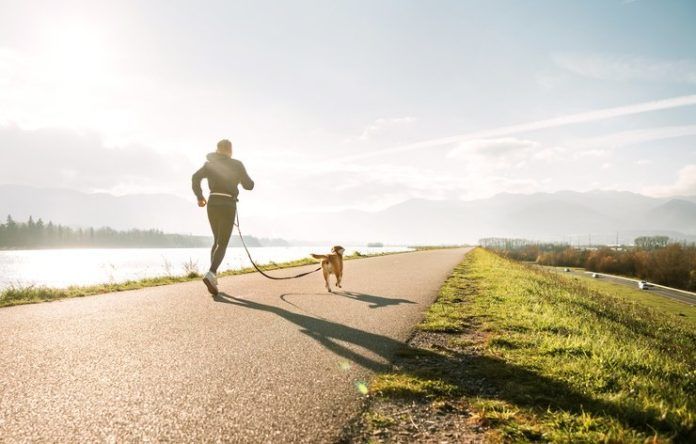It’s been a long winter and maybe you’ve gained a few more pounds than you expected. You watch your dog peacefully sleeping at your feet, and what do you know? He looks a bit heavier as well. Realizing you can both benefit from extra exercise, you ask yourself, “Should I start running with my dog?”
While all dogs like to run to a certain degree, some make better running companions than others. Dalmatians, Doberman Pinschers, Labrador and Golden Retrievers tend to make good running partners, as well as herding dog breeds (but they can get easily bored and look for something to herd along the way, such as a car).
Flat faced dogs – such as Bulldogs, Pugs, Boxers and Pekinese – may have trouble breathing and could overheat quickly during vigorous exercise. Small dogs with short legs will likely have trouble keeping up, so it’s best to run with a dog that is at least the size of a Beagle.

iStock / Getty Images Plus/ Solovyova
Extra-large breeds, such as Great Danes and Mastiffs, shouldn’t run until they’re a year old. Puppies in general can handle a two-mile run when they are five or six months old. If you have any uncertainty about what your puppy or dog can handle, you should check with your veterinarian first. This is especially important with older dogs in order to rule out any health conditions, such as kidney or heart disease.
While overweight dogs will benefit from running, your veterinarian should advise you on how to start your dog off safely. Osteoarthritis could be a problem for some older dogs, but some running is very good to keep the joints mobile. Your veterinarian may suggest some joint supplements for dogs at the beginning of his modest running career.
“Different pets need different amounts of exercise, so you’ll want to talk to your veterinarian before starting your pet’s activity program,” stresses Deborah Linder, DVM, MS, DACVN, head of the Tufts Obesity Clinic for Animals. “Avoid turning your pet into a ‘weekend warrior,’ for example, when an otherwise sedentary dog during the week is brought on an intense hike or run on the weekend which may lead to injuries. Slowly build up to each activity and let your pet guide how much he can do while you monitor for any aches and pains after a new activity.”
Heatstroke in Dogs
Weather conditions can affect how comfortable and safe you and your dog are while running. During hot weather, make sure you run early in the morning or in the evening when the sun is less intense. Make sure your dog has a good drink before you start, and stop for more water periodically. Be aware of signs of heat strokes in dogs, which include panting, excessive drooling, increased body temperature, reddened gums, rapid heart rate and production of small (or no) amounts of urine. If your dog starts pulling back on the leash, that means he is getting fatigued or overheated. It’s time to take a break.
Dogs and cold weather go together well, but if it feels too cold for you, it will be too cold for him. Be cautious whenever the temperatures dip below freezing. Snow can be a problem because it can accumulate between your dog’s toes and cause painful fissures. Well-fitted dog snow boots may be the solution.
Besides snow, be careful of what kind of terrain your dog runs on. Dirt paths are best and gravel is okay. If your dog runs often on concrete, check the pads of his feet because they can get worn down and bleed. Nails can be a problem, too. If too long, rough terrain can cause nail bed injuries, while nails can also be worn down to the “quick” (where the vein and nerve are) on hard terrain. You can buy little caps to put on your dog’s nails or ‘running boots’ to protect them. If your dog starts limping, examine his feet carefully.
Important: Never let a large breed dog run within four hours of eating. This is commonly thought to be a predisposing factor for the deadly condition called gastric dilatation-volvulus, or bloat.
Once you know running is a habit you want to maintain, investing in a dog running harness and a dog running leash can be helpful as well.





